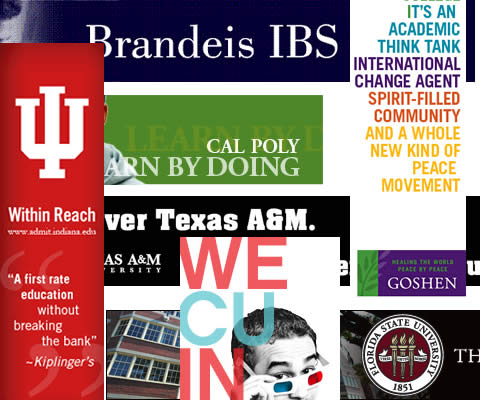College Branding and Banner Ads

Banner ads may be the most common method of reaching consumers on the Web, but they don’t get much respect. Web marketers talk about “banner blindness,” implying that users become so used to the presence of these ads that they no longer even see them. I don’t think it’s time to write off the ubiquitous banner just yet, though. First, here are some comments on college banner ads from top marketing blogger Seth Godin:
Kids apply to schools (a quarter of a million dollar investment) for crazy reasons. A big one: “Well, I’ve heard of it.”
…Being a familiar name takes you miles closer to closing a sale. People like to buy from companies they’ve heard of.
It turns out that this is an overlooked benefit of banner ads. Banner ads are fairly worthless in terms of generating clickthroughs… you have to trick too much and manipulate too much to get clicks worth much of anything. But, if you build ads with no intent of clicks, no hope for clicks… then you can focus on ads that drill your name or picture or phrase into my head. 100 impressions and you’re almost famous. [Emphasis added. From Seth’s Blog – On becoming a household name.]
Low Attention Branding
Why do these banners work? Certainly, some people pay direct attention to them, and some of those even click through to learn more. After all, banners from colleges are highly relevant on a website used to learn about college search and college admissions. If you are a hobbyist and read a magazine related to that hobby, it’s likely that you spend as much time looking at the ads as the editorial content, because the ads are directly related to your interest.
Even when people DON’T pay attention to ads, that doesn’t mean those ads have no impact. The archives of Neuromarketing are full of examples of how information can bypass conscious processing yet still affect our behavior. One example is my recent post, Low Attention Branding:
The results showed an average brand shift of 7.3% for those subjects who paid attention to the ad and could describe it (high attention processors). More interestingly, though, even those subjects who paid little or no attention to the ads saw a positive brand shift. “low attention processors” who could recall the ad only when it was described by the researchers saw a 2.7% shift, and even those “ultra-low attention processors” who couldn’t recall the ad at all saw a 1.2% lift. Not stunning, perhaps, but statistically significant and really not bad for a single “unconscious” exposure.
In Subliminal Branding in Milliseconds, I described other research where an exposure of just five milliseconds – far too fast to be processed consciously – made people view an image more favorably. Even more interesting was that repetition helped that process – subjects who saw the subliminal image 5 times were more favorable to it than those who saw it once. I quote the researcher, Robert Zajonc, as commenting, “The repetition of an experience is intrinsically pleasurable. It augments your mood, and that pleasure spills over to anything which is in the vicinity.”
Branding with Banners: A Case Study
So, here’s the question we set out to answer a few months ago: Do college banner ads work in the name recognition and branding process?

So, we ran a test on College Confidential, the biggest Web community for college-bound high school students. Three colleges that had relatively low national name recognition were advertised for 30 days using only standard banner ads. An independent market research company measured name recognition and “familiarity” before and after the test by polling a large sample of site users. Name recogniton was boosted from 22.3% – 34.2%, and school familiarity was lifted from 14.7% – 24.3%. (Name recognition was indicated by the response, “I have heard of the school, but know almost nothing about it” and familiarity by, “I know where it is located and a little about their programs.”)
Banner blindness, apparently, is somewhat overrated. This lift wasn’t all subliminal – a few of the surveyed students made comments in the post-exposure survey like, “Of course I’ve heard of them, I’ve seen the ads on your website!”
This small experiment clearly showed the value of banners for lifting name recognition and modest familiarity with the school. An interesting follow-on would be to evaluate brand perception in a similar way.
ROI and Accountability
These days, colleges and universities are increasingly (and rightly) focused on improving the accountability of their marketing expenditures. All too often, though, this quest for accountability emphasizes metrics that are easy to collect: clicks, information requests, and so on, to the exclusion of harder to quantify branding benefits. Any effective college marketing effort has to work on branding and differentiation, too. A college that succeeds in increasing its familiarity among its target audience, or in setting its brand apart from its peers, will certainly see better ROI in its lead generation efforts by boosting clicks, inquiries, applications, and enrollment.

